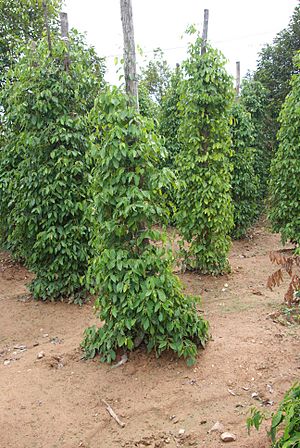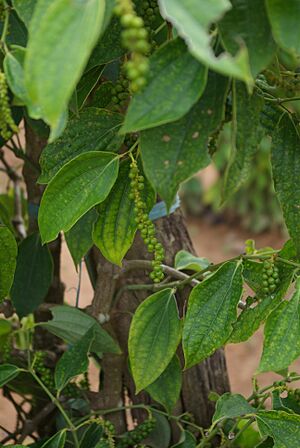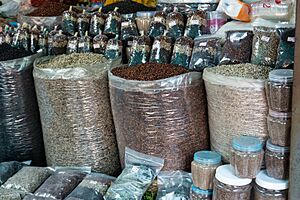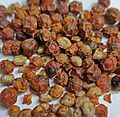Kampot pepper facts for kids
Quick facts for kids Kampot pepper |
|
|---|---|

Kampot pepper plants
|
|
| Genus | Piper |
| Species | P. nigrum |
| Cultivar | Kampot pepper |
| Origin | pre-13th century |
Kampot pepper (Khmer: ម្រេចកំពត; French: Poivre de Kampot) is a special type of black pepper grown in Cambodia. It was once known as poivre d'Indochine during the time of the French protectorate. Its modern name comes from the Province of Kampot, where it is mainly grown. This area also used to include the Province of Kep.
Kampot pepper is a certified "geographical indication" (GI) product. This means its quality is officially linked to its origin. It received this status in Cambodia in 2010 and in the European Union in 2016. There are two main types of Kampot pepper plants: the kamchay (កំចាយ) with "small leaves" and the lampong (or Belantoeung) with "big leaves".
Contents
Where Kampot Pepper Grows
Kampot pepper grows in specific areas of southwestern Cambodia. These are mainly in the Kampot Province and the nearby Kep Province. The special soil and climate here are perfect for growing this unique pepper.
- In Kampot Province:
- Kampong Trach
- Dang Tong
- Tuek Chhou
- Chhouk
- Kampot City
- In Kep Province:
- Kep City
- Damnak Chang'aeur
How Kampot Pepper is Produced
Kampot pepper comes in different colors: green, black, white, and red. All these types come from the same plant! The climate in Kampot Province is ideal for growing pepper. Also, the soil in the Elephant Mountains has a lot of quartz. This helps give Kampot pepper its special taste, known as its terroir.
Growing conditions are very important for Kampot pepper. Farmers in Kampot Province have passed down their knowledge of pepper farming for many generations. This knowledge goes back to at least the 13th century. How the pepper is stored also affects its quality. Different storage methods create different qualities of Kampot pepper.
Pepper farms are checked by the Kampot Pepper Producers Association (KPPA). An independent group called Eco-Cert also inspects them. Only KPPA members who follow strict rules can sell pepper using the "Kampot Pepper" name. This ensures the pepper is always of high quality. In 2020, about 80 tonnes of Kampot pepper were produced.
History of Kampot Pepper
The story of Kampot pepper farming is very old. It was first written about in the 13th century. This was during the Angkorian era, when a Chinese diplomat named Zhou Daguan visited the area.
Serious pepper production began in the 1870s under French colonial rule. By the early 1900s, Cambodia was harvesting around 8,000 tons of Kampot pepper each year. In the 1960s, there were still many pepper plants in Kampot. They produced about 3,000 tons per year. However, the Cambodian Civil War greatly affected production. By the late 1990s, only about 4 tons were harvested each year.
Kampot pepper production slowly started to grow again in the 2000s. Many farmers returned to their lands. By 2015, pepper farms were active in six districts of Kampot province. Most of this special spice was sold to Europe, the United States, Japan, Korea, and Taiwan.
In 2010, Kampot pepper became the first Cambodian product to get "Geographical Indication" (GI) status from the World Trade Organization. This means its unique quality is officially linked to its origin. Since then, more people around the world want to buy Kampot pepper.
How Kampot Pepper is Used
Kampot pepper is a key ingredient in many delicious dishes. Ground black pepper or green peppercorns are used in the famous Kampot Pepper Crab. This dish features crab meat stir-fried with garlic and sweetened soy sauce. Another recipe uses green peppercorns stir-fried with squid and garlic. This is often mixed with palm sugar, oyster sauce, and fish sauce.
Some companies also use Kampot pepper in drinks. For example, Samai Distillery in Phnom Penh uses Kampot Red Pepper to make its special Kampot Pepper Rum.
-
Cambodian prawns with green Kampot peppercorns.







